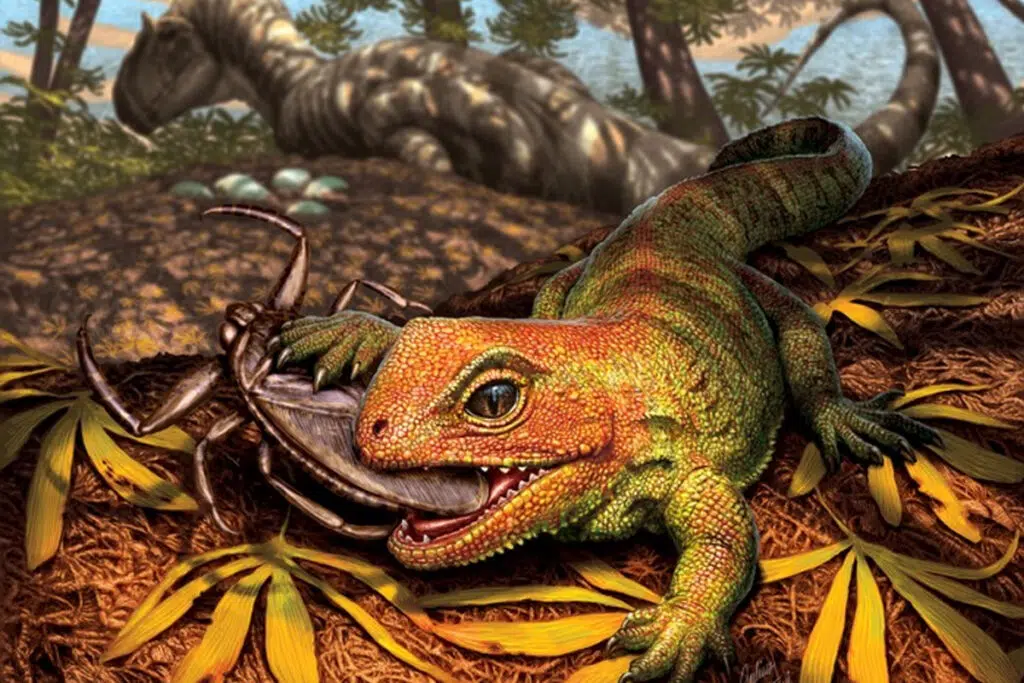
Fossil of Ancient Lizard Ancestor Found in Wyoming
Somewhere near the feet of the Allosaurus, Stegosaurus or some other reptilian giants about 150 million years ago, the six-inch Opisthiamimus gregori, the long-since extinct immediate evolutionary predecessor of contemporary lizards and snakes, was likely foraging through the foliage of Jurassic North America, looking for a meal of insects or smaller invertebrates.
Smithsonian researchers discovered the previously-unknown species of lizard-like reptile, which belongs to the same lineage as New Zealand’s living tuatara, within a handful of specimens, including an extraordinarily complete and well-preserved fossil skeleton, excavated from a site centered around an Allosaurus nest in northern Wyoming’s Morrison Formation — which has been yielding a trove of dinosaur fossils since 1877.
The recent find could help researchers better understand how and why the specific order of reptiles went from being diverse and numerous across the globe in the Jurassic to now being limited just to New Zealand’s tuatara surviving today.
The tuatara looks a bit like a stout iguana, Carrano said, but the tuatara and its newly discovered relative are actually not lizards at all, but rhynchocephalians, an animal line that diverged from lizards at least 230 million years ago, said Matthew Carrano, curator at Smithsonian’s National Museum of Natural History.
The tuatara’s teeth are fused to the jaw bone, resulting in a unique chewing motion that slides the lower jaw back and forth like a saw blade. The animal can also have a 100-year-plus lifespan and a tolerance for colder climates.
“What’s important about the tuatara is that it represents this enormous evolutionary story that we are lucky enough to catch in what is likely its closing act,” Carrano said. “Even though it looks like a relatively simple lizard, it embodies an entire evolutionary epic going back more than 200 million years.”
Through the Jurassic period, rhynchocephalians came in all different sizes large and led diverse lifestyles, from aquatic fish hunters to plant eaters. It’s still a mystery why the majority of the line died off — and lizards and snakes ended up the more common and diverse reptiles across the globe.
Carrano said now that the O. gregori fossil has been given a formal description, it will be added to the museum’s collections, where it will remain available for future study.
The researchers named the new species after museum volunteer Joseph Gregor, who spent hundreds of hours meticulously scraping and chiseling the bones of the O. gregori from a block of stone after the remains were discovered in 2010.
The fossil is almost entirely complete, with the exception of the tail and parts of the hind legs, said Carrano, who noted such a complete skeleton is rare for such small prehistoric creatures because their frail bones are often destroyed either before they become fossilized or as they emerge from an eroding rock formation in the present day. As a result, rhynchocephalians are mostly known to paleontologists from small fragments of their jaws and teeth.
“These animals may have disappeared partly because of competition from lizards but perhaps also due to global shifts in climate and changing habitats,” Carrano said. “It’s fascinating when you have the dominance of one group giving way to another group over evolutionary time, and we still need more evidence to explain exactly what happened, but fossils like this one are how we will put it together.”



